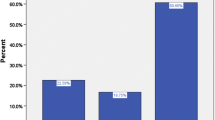Abstract
While robotic technology is being incorporated in therapies, still not enough research has been done to find out how different end-users are willing or able to use robots in their practice. To investigate this issue, a specific study has been designed to determine the preferences of end-users that execute or receive therapies using robots. We applied a participatory design approach which included brainstorming and testing at every stage of the development process. We first determine the preferences of professionals from clinics and schools for children with Autism Spectrum Disorder (ASD). The results indicated that shared (semi-autonomous) control of the robot is preferred in therapies, and mobile devices, like smartphones and tablets, are the preferred interface for the shared robot control. The outcomes of this first stage of research were used as design requirements for the development of a mobile application to be used as an interactive robot control interface. We further developed and tested the application for usability by a broad spectrum of users.
Access this chapter
Tax calculation will be finalised at checkout
Purchases are for personal use only
Similar content being viewed by others
References
Barakova, E.I., Gillesen, J.C.C., Huskens, B.E.B.M., Lourens, T.: End-user programming architecture facilitates the uptake of robots in social therapies. Robot. Auton. Syst. 61(7), 704–713 (2013)
Buchina, N., Kamel, S., Barakova, E.: Design and evaluation of an end-user friendly tool for robot programming. In: 2016 25th IEEE International Symposium on Robot and Human Interactive Communication (RO-MAN), pp. 185–191 (2016)
Zubrycki, I., Granosik, G.: Understanding therapists’ needs and attitudes towards robotic support. the roboterapia project. Int. J. Soc. Robot. 8(4), 553–563 (2016)
Tetteroo, D., Seelen, H., Timmermans, A., Markopoulos, P.: Rehabilitation therapists as software creators?: Introducing end-user development in a healthcare setting. Int. J. Sociotechnol. Knowl. Dev. 6(1), 36–50 (2014)
Zubrycki, I., Kolesiński, M., Granosik, G.: A participatory design for enhancing the work environment of therapists of disabled children. In: 2016 25th IEEE International Symposium on Robot and Human Interactive Communication (RO-MAN), pp. 781–786 (2016)
Berenz, V., Suzuki, K.: Targets-drives-means: a declarative approach to dynamic behavior specification with higher usability. Robot. Auton. Syst. 62(4), 545–555 (2014)
Lourens, T., Barakova, E.: User-friendly robot environment for creation of social scenarios. In: Ferrández, J.M., Álvarez Sánchez, J.R., de la Paz, F., Toledo, F.J. (eds.) IWINAC 2011. LNCS, vol. 6686, pp. 212–221. Springer, Heidelberg (2011). doi:10.1007/978-3-642-21344-1_23
Diprose, J., MacDonald, B., Hosking, J., Plimmer, B.: Designing an API at an appropriate abstraction level for programming social robot applications. J. Vis. Lang. Comput. (2017, in press). https://doi.org/10.1016/j.jvlc.2016.07.005, Accessed 7 Jul 2016
Gnjatović, M.: Therapist-centered design of a robot’s dialogue behavior. Cogn. Comput. 6(4), 775–788 (2014)
Barakova, E.I., Bajracharya, P., Willemsen, M., Lourens, T., Huskens, B.: Long-term LEGO therapy with humanoid robot for children with ASD. Expert Syst. 32(6), 698–709 (2015)
Boehm, B.W.: A spiral model of software development and enhancement. Computer 21(5), 61–72 (1988)
Harris, S.L., Delmolino, L.: Applied behavior analysis: its application in the treatment of autism and related disorders in young children. Infants Young Child. 14(3), 11–17 (2002)
Schreibman, L., Kaneko, W.M., Koegel, R.L.: Positive affect of parents of autistic children: a comparison across two teaching techniques. Behav. Ther. 22(4), 479–490 (1991)
Koegel, R.L., Koegel, L.K., McNerney, E.K.: Pivotal areas in intervention for autism. J. Clin. Child Adolesc. Psychol. 30(1), 19–32 (2001)
Huskens, B., Verschuur, R., Gillesen, J., Didden, R., Barakova, E.: Promoting question-asking in school-aged children with autism spectrum disorders: effectiveness of a robot intervention compared to a human-trainer intervention. Dev. Neurorehabil. 16(5), 345–356 (2013)
Verschuur, R., Huskens, B., Verhoeven, L., Didden, R.: Increasing opportunities for question-asking in school-aged children with autism spectrum disorder: effectiveness of staff training in pivotal response treatment. J. Autism Dev. Disord. 47(2), 490–505 (2017)
Koegel, R.L., Bradshaw, J.L., Ashbaugh, K., Koegel, L.K.: Improving question-asking initiations in young children with autism using pivotal response treatment. J. Autism Dev. Disord. 44(4), 816–827 (2014)
Kozima, H., Nakagawa, C., Yasuda, Y.: Interactive robots for communication-care: a case-study in autism therapy. In: ROMAN 2005. IEEE International Workshop on Robot and Human Interactive Communication, pp. 341–346 (2005)
Thill, S., Pop, C.A., Belpaeme, T., Ziemke, T., Vanderborght, B.: Robot-assisted therapy for autism spectrum disorders with (partially) autonomous control: challenges and outlook. Paladyn 3(4), 209–217 (2012)
Goodrich, M.A., Crandall, J.W., Barakova, E.: Teleoperation and beyond for assistive humanoid robots. Rev. Hum. Factors Ergon. 9(1), 175–226 (2013)
Kim, M.G., Oosterling, I., Lourens, T., Staal, W., Buitelaar, J., Glennon, J., Smeekens, I., Barakova, E.: Designing robot-assisted pivotal response training in game activity for children with autism. In: 2014 IEEE International Conference on Systems, Man, and Cybernetics (SMC), 5–8 October 2014
Author information
Authors and Affiliations
Corresponding author
Editor information
Editors and Affiliations
Rights and permissions
Copyright information
© 2017 Springer International Publishing AG
About this paper
Cite this paper
Martin-Ortiz, M., Kim, MG., Barakova, E.I. (2017). Mobile Application for Executing Therapies with Robots. In: Rojas, I., Joya, G., Catala, A. (eds) Advances in Computational Intelligence. IWANN 2017. Lecture Notes in Computer Science(), vol 10306. Springer, Cham. https://doi.org/10.1007/978-3-319-59147-6_8
Download citation
DOI: https://doi.org/10.1007/978-3-319-59147-6_8
Published:
Publisher Name: Springer, Cham
Print ISBN: 978-3-319-59146-9
Online ISBN: 978-3-319-59147-6
eBook Packages: Computer ScienceComputer Science (R0)




